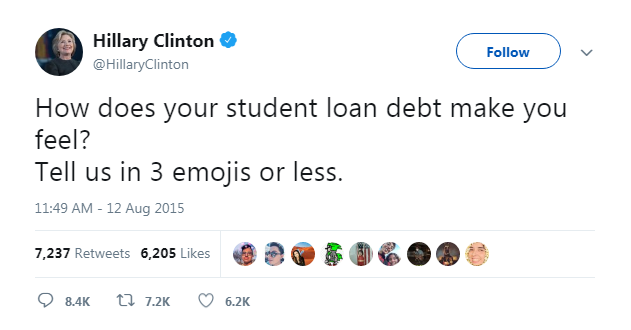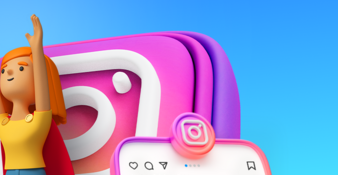Why and how to use emojis on social media?

Half the trouble with SMM is actually just learning to get with the times. Social media is a fast-paced, dynamic place where rules change by the minute. The better you are at adopting the habits of its users, and keeping up with trends, the better your results will be.
In saying that, one factor of social media marketing that people often tend to underestimate is the use of emojis. Emojis, as insignificant as they may look, can serve as a language of its own. What most people fail to realize is that now, you can use emojis to communicate with your audience in a visual manner.
We’re here to show you four reasons why emoticons are so important for your brand - as well as how to use them properly in your marketing plan.
1. Emojis are an important aspect of visual marketing
If you’ve been around the digital marketing block, you’ll know that everybody’s betting their money on visual marketing. Marketing experts often talk about the importance of hooking your audience up with powerful visuals everywhere you look, and we’ve explored the subject in detail over at Amplifr’s blog on quite a few occasions. However, one simple fact remains: attention is simply not an easy catch these days. So in order to stand out on the internet, you have to work on your branding while also creating a distinct visual presence.
Although emojis are certainly not the first thing that comes to mind when we talk about visuals, they are undoubtedly an essential part of online communication. In fact, 92% of online consumers use them (stats from 2015). Emojis essentially take words back to ideograms - a tiny picture expressing a single idea.
Not only do emoticons reduce word count and make your message look less cluttered, they also more visually attractive. And for those times when you lack the much needed visual element in your content (like pictures or videos,) an emoji can certainly do the trick without too much fuss.
2. Emojis are international
Another factor that shows exactly how convenient emojis are is the fact that everybody can understand them. The language of the internet has developed a grammar of its own and emojis are its new punctuation. The best thing about it? It’s international! Everybody understands the basic symbolism of a smiley face, or a pizza slice, or a palm tree emoji -- making it ever more important to use to your brand’s advantage.

3. You can reach millennials
If the previous two arguments weren’t enough for you, then this one might be: emojis are non-negotiable in the communication of millennials, and Generation Z - the newest addition to the consumer market. Besides being the newest, both these consumer demographics are also the most technologically savvy, and they don’t care much about ads. The trick to getting them is to pay attention to the ways they engage with content on social media - and to use it within your branded content.
4. Emojis make your content more relatable
When do millennials engage with branded content? When it doesn’t seem much different than their own - content that is user-created. Emojis are such a common feature of internet communication -- 60 million emojis are being sent daily on Facebook messenger alone, and around the world, 250 to 350 emojis are tweeted per second. You can even confirm this statistic yourself by casting a single glance at the real time visualization of emojis used on Twitter over at the Emoji Tracker.
It makes perfect sense that using emojis with your branded content on social media is one sure way to make it more relatable to users. Brands have already started realizing this: stats dating from 2016 tell us that emoji usage in marketing messages has been increasing by 775% on an annual basis.
How to use emojis on social media:
We’ve already established that it’s important to not overlook emojis in your brand’s marketing efforts, but how does one incorporate them successfully? To help you, we’ve compiled a list of our favorite uses of emojis for social media marketing to humanize your brand.
1. Make sure that you are using emojis in an appropriate way (that makes sense)
Did you happen to catch that really popular, often talked-about tweet from Hillary Clinton?

It shows us exactly how not to use emojis to make light of a situation that should be taken very seriously.
Because emojis are a way to convey emotion, they should be considered for a proper tone of voice in the same way you would consider what words to use in your text.
Things that you should be careful about:
● Emojis are meant to complement a message. If they don’t make sense, they don’t add any value to your message
● You need to be careful about emoji use for serious matters. If you think there’s a chance that someone might be offended, don’t use the emoji.
● Use emojis for your business the way you’d use them for everyday private communication.
● If you can’t think of what emoji you need for a certain post, then maybe you don’t need one.
● Don’t go crazy with them and give your audience an emoji overload. Stay on the safe side, and limit the number of emojis in a single message under 4.
● Always research what an emoji means. Although you might think you know, there might be some context you are not aware of. Taking a moment to understand is just a tiny little precaution, and it can save you from an embarrassing emoji flop. You can use online resources such as Emojipedia to get the details on a particular emoji.
When you’re preparing your calendar of branded content, always take the tone of voice you’d like to use into account throughout your social media campaigns, and always stay respectful to your consumers.
2. Stay consistent to your branding
You can really step out of the corporate box by using emojis in your marketing plan. They can make your brand messages more playful, lighthearted, and can help you sound less rigid. However, you need to keep in mind that they should always be used in context.
For instance, if you’re managing a law firm, you wouldn’t exactly market your services on social media by using blowing kisses or by throwing in the tears of joy emoji. No one expects it from you, and you’ll probably be taken less seriously. Unfortunately, professional businesses like that might actually benefit the most by using the most common types of emojis out there: good old smiley faces and thumbs up.
But if your line of work is in itself more lighthearted, then you can really take that to your advantage via your social media branding.

3. Use emojis in your posts and comments
Always use emoticons when you’re engaging directly with a customer or an audience: in comments and messages. As marketers, we have to constantly remind ourselves how important it is to actually engage with our audience and customers, and that’s the most natural place you could use an emoji!
Finally, don’t forget to use them in the copy of your posts, and most importantly, in your call-to-actions.
4. Use them for mobile marketing, chatbot marketing and customer service
Emojis wouldn’t be emojis if they didn’t depict human emotion and reaction, and what better place to use them than in their natural habitat - messaging apps! Bot use is becoming a major trend in social media marketing because it offers unprecedented possibilities for interacting with your consumers in the very messenger apps they spend hours and hours in every single day.
But the biggest throwback to using automated messages for customers is the fact that sometimes it can feel too automated to consumers - they’d rather just talk to real people. This is where emojis come into play - by adding them, the language you use in your automated chatbots can feel much more lively and natural.
If you have an app, it’s ideal that you include emoticons in your notifications for offers and discounts. You can’t deny the power of mobile marketing. What’s better than appearing on your user’s home screen on their mobile phones?
Brainstorm interesting ways for consumers to interact with your mobile apps or social media profiles. Take Domino’s example - they created a social media ordering system where customers could order a pizza through messages on Twitter by simply sending the cute pizza emoji.
5. Make your own emojis
All the previous points we’ve made refer to the appropriate ways to incorporate existing emojis in your social media marketing. But brands all over are taking the extra step - making their own. The very fact that Snapchat bought the Bitmoji app tells us how big the trend of emoji personalization has become.
The internet is swarming with examples of brands using custom emojis to spread their message. Remember the Washington World Wildlife Fund and their endangered emoji campaign? Yes, it’s precisely what it sounds like - they created 17 endangered animal emojis and used them to inspire people to donate.
There are a lot of custom emoji makers out there.
Pro tip:
If you don’t think the extra trouble of creating your own custom branded emoji is worth it, you can take a shortcut and use a composer tool like Amplifr’s emoji composer. You’ll get a personalized emoji experience with a nice, visually appealing background - all without actually making a personalized emoji. Check out this article where we explain how to do it in detail.













